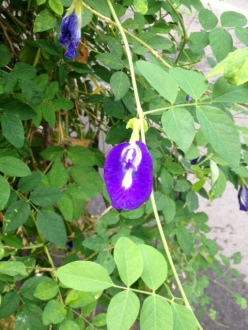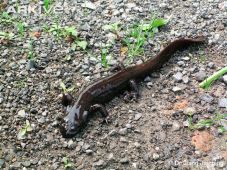Some botanists have a weird sense of humour when it comes to nomenclature or their EQs are pretty bad. This came to mind as I was pointing out the names of plants to my kids in a bid to rub some of the city-slicker off them.
Interestingly, a number of these unfortunate plants are often cited as examples in the local primary school Science syllabus.
Consider these:
Clitoria Ternatea
Yeah, right. Just because it looks like one doesn’t mean you have to call it out. And to think that legions of nonyas use this pretty blue

flower as a dye for their kuih-kuih or bak chang.
Many of us growing up in the 80s and 90s would have seen these in the Science textbooks too. I really can’t remember why these flowers were featured specifically. Probably because they were commonly found throughout Singapore at the time.
Freudians would have a field day with this poor bud I’m sure, given the chance.
Bauhinia Kockiana or Kock’s Bauhinia

My son smirked and the daughter blanched when I told them the name of this gorgeous but luridly-named plant the other day.
So Mr Kock created this hybrid, and I’m sure he’s very proud of it. But for goodness’ sake, how about another more suitable name for this very pretty flower?
Orchid

My parents were orchid enthusiasts and even today, we still have these most difficult of plants, maintenance wise, in our garden.
Did you know though that the Orchid comes from the greek word Orkhis meaning, ahem, testicle?
Ah well, you learn something new every day.
Puffball or Lycoperdon
There’s also the puff ball, yet another strange organism that appeared in a leading girls’ primary school exam paper as an example for reproduction through spores.

Photo credit: http://www.fcps.edu/islandcreekes/ecology/pear-shaped_puffball.htm
This is a direct translation of the puffball according to wikipedia: The name comes from lycos meaning wolf and perdon meaning to break wind; thus the name literally means wolf-farts.
Uh huh. I’m sure the teachers who set that paper knew this when they created that question.
Finally, plants are not the only ones. Animals too are not spared. I present to you a fine specimen: The Longdong stream salamander or Batrachuperus Longdongensis.

Photo Credit: http://www.arkive.org/longdong-stream-salamander/batrachuperus-londongensis/
If you really have nothing better to do with yourself, check out http://www.curioustaxonomy.net for more weird and fantastic stories about how plants and animals get their names. It will make for sparkling dinner conversation. I guarantee it.
Footnote:

Credit:
http://www.trilliumresearch.org/species2.html
By the way, as I was googling about botanical nomenclature, I came across this charming description in Home & Garden (http://nwsdy.li/1jfqUhW) of the honourable guy who started it all: “Carl Linnaeus, the father of botanical nomenclature, was considered a pretty rude and offensive guy in his day. His classification of plants largely focused on their similarities to human genitalia and sexuality. Back in the 1700s, he referred to stamens as husbands, and pistils as wives, shocking the community at large. Pretty much, he was regarded as a pervert.”
